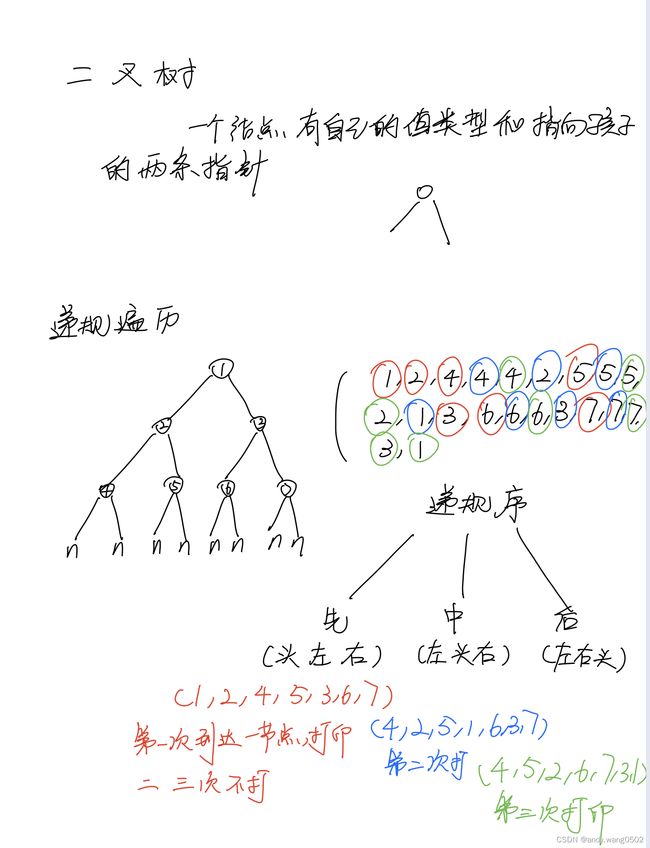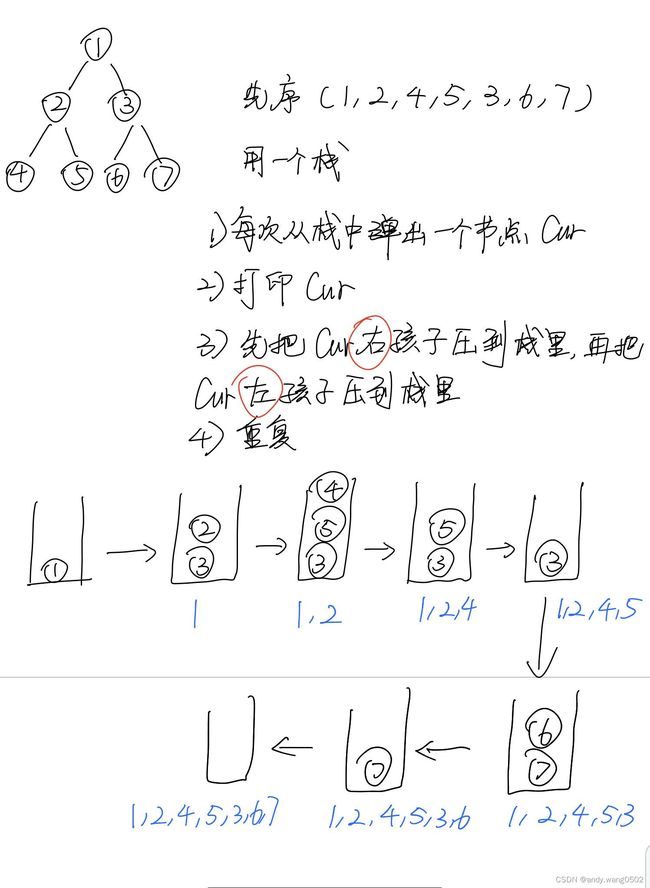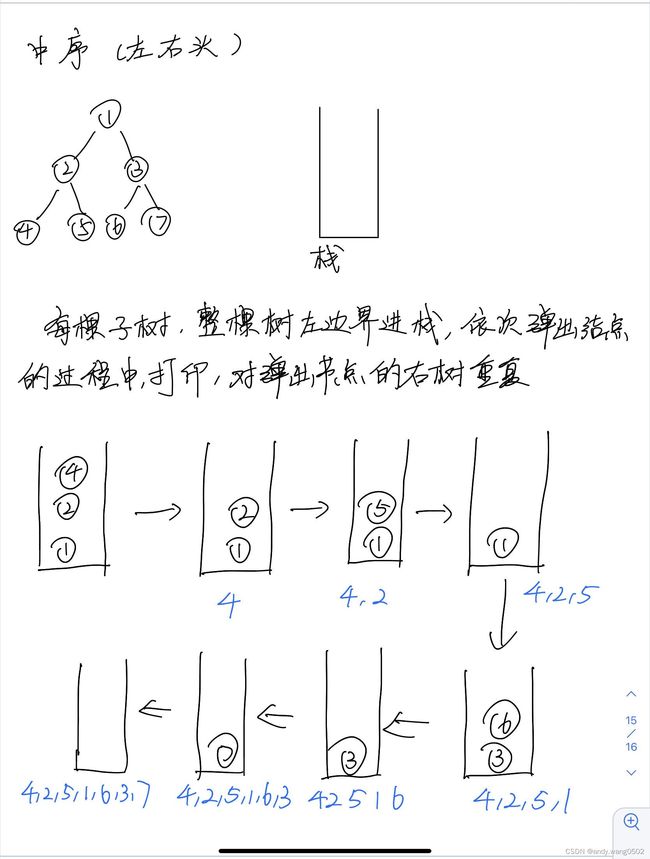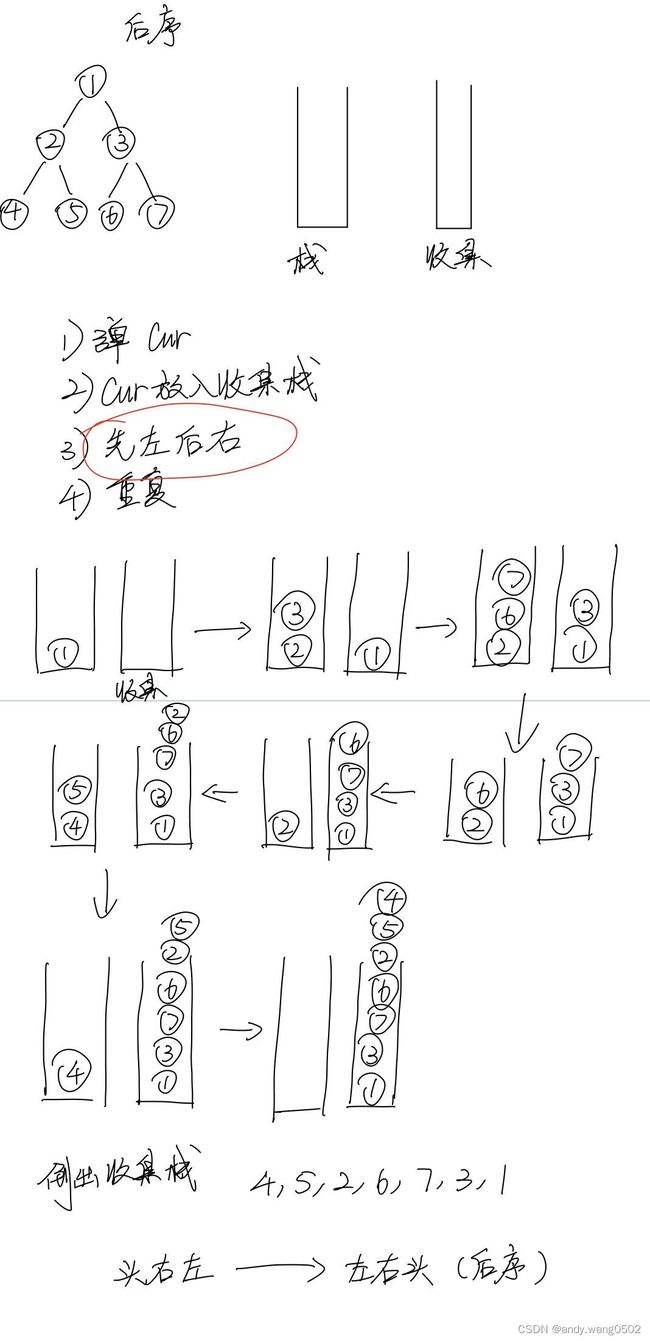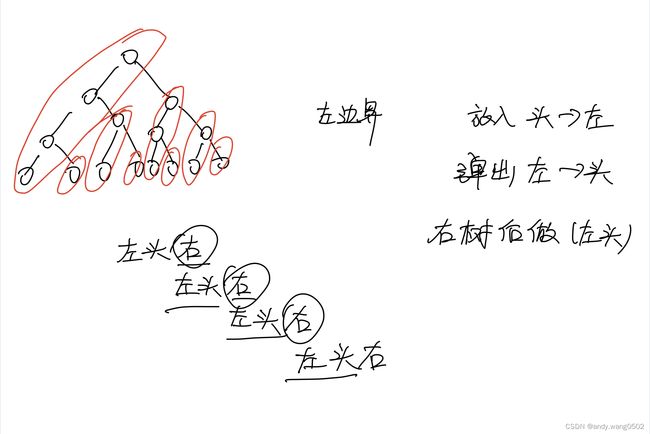B站左程云算法视频笔记05
两个链表相交的一系列问题
题目:给定两个可能有环也可能无环的单链表,头结点head1和head2,请实现一个函数,如何两个链表相交,请返回相交的第一个节点,如果不相交,返回null
要求:如果两个链表长度之和为N,时间复杂度要在O(N),额外空间复杂度O(1)
分析:1.判断有无环2.判断的是两个链表中是否有节点的内存地址一样,和值无关
第一步:判断有无环,有环返回第一个入环节点。分为哈希表和快慢指针的做法可实现
第二步:讨论,获知了两个链表是否有环,分情况讨论。都无环,可能相交也可能不相交,讨论两个链表的尾节点的地址是否一致,不是,则不相交,一致,则让长链表先走两个链表长度的插值步之后,再一起走,会在第一个相交节点相遇;一个有环,一个无环,不相交,返回null;都有环,分为三种情况,不相交,相交且入环节点一样,相交但入环节点不一样。
都有环的三种情况区分较复杂,首先判断判断入环节点一样时,则链表1和链表2 的入环节点的内存结点相等,此时,我们可以把入环节点看作是终止节点,则将问题转换成了都无环时候的情况;入环节点不一样时,给一个指针指向链表1的入环节点,继续往下走,在遇到自己之前,遇到了2的入环节点,则返回1或2的入环节点,如果没遇到,则说明不相交,返回null。
代码:
//找到第一个入环节点,如果无环,则返回空
public static Node getLoopNode(Node head){
if(head == null || head.next == null || head.next.next == null){
return null;
}
Node n1 = head.next; //n1 -> slow
Node n2 = head.next.next;//n2 -> fast
while( n1 != n2 ){
if(n2.next ==null || n2.next.next == null){
return null;
}
n2 = n2.next.next;
n1 = n1.next;
}
n2 = head; // n2-> walk again from head
while(n1 != n2){
n1 = n1.next;
n2 = n2.next;
}
return n1;
}
//如果两个链表都无环,返回第一个相交节点,如果不相交则返回空
public static Node noLoop(Node head1, Node head2){
if(head1 == null || head2 == null){
return null;
}
Node cur1 = head1;
Node cur2 = head2;
int n = 0;//两个链表的长度差值
while(cur1.next != null){//到最后一个节点停
n++;
cur1 = cur1.next;
}//得到链表1的最后一个节点
while(cur2.next != null){
n--;
cur2 = cur2.next;
}//链表2的最后一个节点
if(cur1 != cur2){
return null;
}最后一个链表不等,则不相交
cur1 = n > 0? head1:head2; //cur1指向长的链表的头结点
cur2 = cur1==head1? head2:head1;//cur2指向短的
n= Math.abs(n); n取绝对值
while(n != 0){
n--;
cur1 = cur.next;
}//长的先走
while(cur1 != cur2){
cur1 = cur1.next;
cur2 = cur2.next;
}
return cur1;
}
//两个有环链表,返回第一个相交节点,不相交返回null
public static Node bothLoop(Node head1, Node loop1, Node head2, Node loop2){
Node cur1 = null;
Node cur2 = null;
if(loop1 == loop 2){
cur1 = head1;
cur2 = head2;
int n = 0;
while(cur1 != loop1){
n++;
cur1 = cur1.next;
}
while(cur2 != loop2){
n--;
cur2 = cur2.next;
}
cur1 = n>0? head1:head2;
cur2 = cur1 == head1? head2:head1;
n =Math.abs(n);
while(n != 0){
n--;
cur1 = cur1.next;
}
while(cur1 != cur2){
cur1 = cur1.next;
cur2 = cur2.next;
}
return cur1;
}else{
cur1 = loop1.next;
while(cur1 != loop1){
if(cur1 == loop2){
return loop1;
}
cur1 = cur1.next;
}
return null;
}
}
public statci Node getIntersectNode(Node head1, Node head2){
if(head1 == null || head2 == null){
return null;
}
Node loop1 = getLoopNode(head1);
Node loop2 = getLoopNode(head2);
if(loop1 == null && loop2 =null){
return noLoop(head1, head2);
}
if(loop1 !=null && loop2 != null){
return bothLoop(head1, loop1, head2, loop2);
}
return null;
}二叉树节点结构
递归行为三次达到自己
public static void f(Node head){
//1
if(head == null){
return;
}
//1
f(head.left);
//2
f(head.right);
//3
}public static preOrderRecur(Node head){
if(head == null){
return;
}
System.out.print(head.value+"");//第一次打印是先序
preOrderRecur(head.left);
preOrderRecur(head.left);
}
public static inOrderRecur(Node head){
if(head == null){
return;
}
inOrderRecur(head.left);
System.out.print(head.value+"");//第二次打印是中序
inOrderRecur(head.left);
}
public static posOrderRecur(Node head){
if(head == null){
return;
}
posOrderRecur(head.left);
posOrderRecur(head.left);
System.out.print(head.value+"");//第三次打印是后序
}任何递归函数都可改成非递归
public static void preOrderUnRecur(Node head){
System.out.print("pre-order: ");
if(head ! = null){
Stack stack = new Stack();
stack.add(head);
while(!stack.isEmpty()){
head = stack.pop();//弹出
System.out.print(heaf.value+" ");
if (head.right != null){
stack.push(head.right);
}
if(head.left != null){
stack.push(head.left);
}
}
}
System.out.println();
} public static void inOrderUnRecur(Node head){
System.out.print("in-order: ");
if(head != null){
Stack stack = new Stack();
while(!stack.isEmpty() || head! == null){
if(head != null){
stack.push(head);
head = head.left;
}else{
head = stack.pop;
System.out.print(head.value+" ");
head = head.right;
}
}
}
System.out.println();
}
public static void posOrderUnRecur(Node head){
System.out.print("pos-order: ");
if(head ! = null){
Stack s1 = new Stack();
Stack s2 = new Stack();//收集
s1.push(head);
while(!s1.isEmpty()){
head = s1.pop();//弹出
s2.push(head);
if(head.left != null){
s1.push(head.left);
}
if (head.right != null){
s1.push(head.right);
}
}
while(!s2.isEmpty()){
System.out.print(s2.pop.value+"")
}
}
System.out.println();
}
所有的树都可以被左边界分解掉
设计题:如何完成二叉树的宽度优先遍历(求一棵二叉树的宽度)LeetCode662和102 《剑指offer》32
队列,先放左再放右
宽度优先遍历
public static int void w(Node node){
if(head == null){
return;
}
Queue queue = new LinkedList<>();
queue.add(head);
while(!queue.isEmpty()){
Node cur = queue.poll();
System.out.println(cur.value);//弹出就打印
//先放左再放右边
if(cur.left != null){
queue.add(cur.left);
}
if(cur.right != null){
queue.add(cur.right);
}
}
} 求出最大宽度
思路:准备一个levelMap记录点在第几层,设置三变量,当前在哪一层curLevel,当前层发现几个节点curLevelNodes,所有层中哪一层发现的节点最多的max
public static int void w(Node node){
if(head == null){
return;
}
Queue queue = new LinkedList<>();
queue.add(head);
HashMap levelMap = new HashMap<>();//记录每个节点对应的层数
levelMap.put(head,1);//放入第一个节点
int curLevel = 1;//当前节点所在的层数
int curLevelNodes = 0;//当前层发现几个节点数
int max = Integer.Min_VALUE;//哪一层发现的最多的节点数
while(!queue.isEmpty()){
Node cur = queue.poll();
int curNodeLevel = levelMap.get(cur);//节点的层数
if(curNodeLebel == curLevel){//节点是否是当前统计的层
curLevelNodes++;
}else{
max = Math.max(max,curLevelNodes);
curLevel++;
curLevelNodes=1;
}
//先放左再放右边,记录每个点所在的层数
if(cur.left != null){
levelMap.put(cur.left, curNodeLevel+1);
queue.add(cur.left);
}
if(cur.right != null){
levelMap.put(cur.right, curNodeLevel+1);
queue.add(cur.right);
}
}
} 不用哈希表的方法
使用队列,变量,当前层最后一个节点curend,下一层最后一个节点nextend,当前层已经发现的节点数curlevelNode,谁进栈,谁就是nextend,当出队列的节点是curend时,max抓取记录的curlevelNode。
